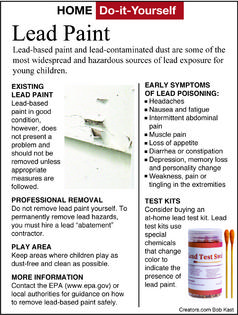Here's How: Be Careful Around Old Lead Paint
Dear James: We are remodeling our old house which has a lot of painted wood trim. Is there a potential problem with lead being released as we tear out or refinish the wood trim? -- Dennis W.
Dear Dennis: If your house was built before 1978, there is a chance that paint which contains lead was used, especially on the wood trim. Leaded paint was not allowed to be used after that time, but some builders or painters may still have had some old paint on hand. It is something to take seriously.
Although people often think about possible lead poisoning when doing interior remodeling jobs, outdoor remodeling jobs can also allow contact with paint containing lead. Lead-laced dust will not accumulate in the air outdoors like it does indoors, but inhaling the dust as you work or handling outdoor paint chips creates a hazard too.
Not all houses built before the 1980s contain lead, but definitely have some paint samples tested before doing any work. There is a lot of information about lead available from the EPA. Another good source for information is the National Center for Healthy Housing, www.nchh.org.
If you do an internet search, you will find many companies that offer lead test kits for about $10. Although many of them provide accurate tests, to be safe, it is best to stick with EPA-recommended or professional testing.
Keep in mind that older homes probably have many layers of paint, so the lead paint many be buried well below the surface. If the lower layers are not disturbed by remodeling, a dog chewing, etc., it is not a significant hazard. Don't just try to remove all the old paint to eliminate lead.
If you have done previous remodeling work in your house yourself and were not aware of the lead poisoning hazard, a simple blood test can determine if you or your children have lead poisoning. It is estimated that 1 out of every 11 children in the U.S. have dangerous levels of lead in their bloodstream. Many do not show any obvious symptoms of lead poisoning.
Lead is typically introduced into the body by mouth and breathing. A child or pet can either eat paint that chips off or chew on a painted surface. Just the friction from between painted surfaces on doors and windows as they open and close can create airborne and settled lead-laced dust.
People often ask why such a dangerous chemical as lead was ever used in paint in homes in the first place. Lead is an excellent material to increase the opacity of paint, so that the new paint will hide what is beneath it. It was also used in some clear varnishes as a drying agent.
If you have your paint tested and no lead is detected, then go ahead and start your remodeling job yourself. Even though no lead is present, it is still wise to block off the work area to minimize inhaled dust of any kind. ZipWall makes easy-to-use spring-loaded supports to quickly build a plastic film wall around your project.
If lead was detected in your test sample, DO NOT attempt to do any of the remodeling work yourself. You will need to have a professional remodeler, well versed in working with lead paint, do the work for you. Until the work is started, paint over any areas where paint is exposed and advise your children not to touch them.
You might consider changes to your cleaning habits in a house with lead paint present. Wet mopping is best to minimize airborne lead as you clean. A high-quality HEPA (high efficiency particulate air) vacuum cleaner would be a good choice. A central vacuum that vents outdoors would be even better.
========
Send your questions to Here's How, 6906 Royalgreen Dr., Cincinnati, Ohio, 45244 or visit www.dulley.com. To find out more about James Dulley and read features by other Creators Syndicate writers and cartoonists, visit the Creators Syndicate website at www.creators.com.
Copyright 2024 Creators Syndicate Inc.







